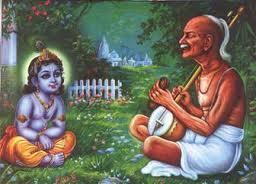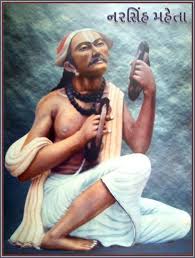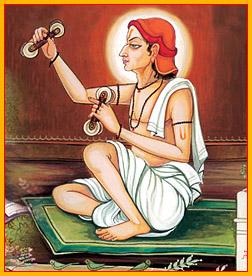‘বৈষ্ণব জান’, মহাত্মা গান্ধীর প্রিয় গানটি মুষ্টিমেয় ভারতীয় স্তবগুলির মধ্যে একটি, যা বিশ্বব্যাপী এবং ভারত জুড়ে শত লক্ষ্য লোকের দ্বারা বিস্তৃতভাবে অঘোষিত জাতীয় সংগীতের মর্যাদা পেয়েছে। এটির রচয়িতা নরসিংহ মেহতা, যিনি নরসী মেহতা বা নরসী ভগত নামেও পরিচিত। তিনি ছিলেন পঞ্চদশ শতাব্দীর ঐতিহ্যপূর্ণ হিন্দু ধর্মীয় বৈষ্ণব কবি। গুজরাটের "আদি কবি" বা অগ্রণী কবি হিসাবে বিবেচিত চার শতাব্দীরও বেশি সময় ধরে তিনি গুজরাটের এক শ্রদ্ধেয় ব্যক্তি ছিলেন। তিনি কেবল গুজরাটি কাব্যিক রূপই আবিষ্কার করেননি, বরং এটিকে সর্বোচ্চ সংগীত ও দার্শনিক প্রকাশের স্তরেও তুলেছেন। কবিতা, গান, গীতসংহিতা এবং শ্লোক হিসাবে নরসিংহ যা যা রচনা করেছিলেন তার বেশিরভাগই জনসাধারণের চেতনাতে বিস্মৃত, উদযাপিত এবং স্থাপিত হয়। তাঁর সাহিত্যিক সৃষ্টিগুলি বহু শতাব্দী ধরে সৌররাষ্ট্র অঞ্চলের মধ্যে বিস্তৃত হয়, গান্ধীর জন্মের বহু বছর আগেই তিনি জাতিকে তার সাহিত্য সম্পদ দান করেছেন। তিনি কেবল শ্রীকৃষ্ণের একনিষ্ঠ ভক্ত ছিলেন না, তিনি ছিলেন একজন সাহসী সমাজ সংস্কারকও। আরেকটি কাজ যা গান্ধীকে অভূতপূর্ব খ্যাতি দিয়েছে - তফসিলি বর্ণ ও তফসিলী উপজাতির লোকদের "হরিজন" হিসাবে চিহ্নিত করা গান্ধীর মস্তিষ্ক প্রসূত ছিল না, তা ছিল নরসী মেহতার মস্তিষ্ক প্রসূত। (অনন্ত পাই, ১৯৯৪) বিন্দুঃ
- ‘হরিজন’ শব্দটি প্রথম মধ্যযুগীয় কবি-সাধক নরসিংহ মেহতা ব্যবহার করেছিলেন, গান্ধী যাঁর দীর্ঘকাল প্রশংসা করেছিলেন (মেহতার ‘বৈষ্ণব জানা তো’ তাঁর অন্যতম প্রিয় স্তোত্র)। – (হ্যারল্ড, আর.আইস্যাকস, ১৯৬৫) লিখেছেন যে গান্ধীজী তাদের নাম রেখেছিলেন হরিজন যেখানে ‘হরি’ মানে ঈশ্বর, ‘জান’ মানে মানুষ এবং এইভাবে ‘হরিজন’ অর্থ “ঈশ্বরের মানুষ”। গান্ধীজি সম্ভবত গুজরাতের কবি নরসিংহ মেহতার কাছ থেকে এই শব্দটি ধার নিয়েছিলেন যিনি তাঁর ভক্তিগীতিতে “হরিজন” শব্দটি প্রথমে ব্যবহার করেছিলেন।
হ্যারল্ড আর আইজ্যাকস, ইন্দিয়াস এক্স-আনটাচেবেল। নিউ ইয়র্ক; জন ডে কোম্পানি, ১৯৬৫ - ১৯৩৩ সালে তিনি তাঁর সাপ্তাহিক পত্রিকা ইয়ং ইন্ডিয়ার নাম হরিজন রাখেন, কারণ তিনি বিশ্বাস করেছিলেন যে অস্পৃশ্যতা বিলোপের অভিযান রাজনৈতিক স্বাধীনতা অর্জনের মতোই জরুরী। যুবক (বা তরুণ) এবং প্রবীণ, বর্তমান এবং ভবিষ্যত ভারতকে এই পবিত্র উদ্দেশ্যে নিজেকে প্রতিশ্রুতিবদ্ধ হতে হয়েছিল। নামটি দ্রুত জনপ্রিয়তা অর্জন করে হিন্দু মধ্যবিত্ত শ্রেণি এবং জাতীয়তাবাদী সংবাদমাধ্যমের মধ্যে। অস্পৃশ্যদের এখন নিয়মিত ‘হরিজন’ বলা হত।
১৯৩২ সালের সেপ্টেম্বরে, গান্ধী একটি ‘অস্পৃশ্যতা বিরোধী লীগ’ গঠন করেছিলেন, যা ডঃ বি আর আম্বেদকারের সাথে পুনা চুক্তিতে স্বাক্ষর করার পরে ‘হরিজন সেবক সংঘ’ নামে নামকরণ করা হয়েছিল। - পুরাতন গুজরাতিতে নরসিংহ মেহতার ১৫ তম শতাব্দীর কবিতা, বৈষ্ণব জন তো তেনে কাহিয়ে, যা মহাত্মা গান্ধী সাবারমতি আশ্রমে নিয়মিতভাবে প্রার্থনা হিসেবে গাইতেন।
- ভজনের কেন্দ্রীয় থিম, সহমর্মিতা, যা অন্য একজন মানুষের দুঃখকে অনুভব করতে সাহায্য করে। একজন ব্যক্তিকে পুণ্যাত্মা হিসাবে বিবেচনা করা যায়, কেবলমাত্র সে যদি অন্যের বেদনা অনুভব করতে পারে, যদি সে অন্যের আঘাত প্রশমিত করতে চেষ্টা করে এবং যদি সে তার নিজের মমত্ববোধকে অহংকার হিসেবে গণ্য না করে।
নরসিংহ মেহতা তালাজায় বৈষ্ণব নগর সম্প্রদায়ের মধ্যে জন্মগ্রহণ করেছিলেন। তিনি ৫ বছর বয়সে পিতামাতাকে হারিয়েছিলেন। ৮ বছর বয়স পর্যন্ত তিনি কথা বলতে পারেননি বলে কথিত আছে যে তিনি বৈষ্ণব সাধকের আশীর্বাদে তাঁর বাকশক্তি ফিরে পেয়েছেন। তাঁর বেড়ে ওঠা তাঁর দাদীমা জয়গৌরীর কাছে। তিনি মানেকবাইকে বিয়ে করেছিলেন সম্ভবত ১৪২৯ সালে। মেহতা এবং তাঁর স্ত্রী জুনাগড়ে ছিলেন তাঁর ভাই বনসীধরের কাছে। তবে তাঁর ভাইয়ের স্ত্রী খুবই রুক্ষস্বভাবের মহিলা ছিলেন, তাই সর্বদা নরসিংহ মেহতাকে তাঁর উপাসনার জন্য অপমান ও ভৎসনা সহ্য করতে হত। তিনি বাড়ি ত্যাগ করে শান্তির সন্ধানে নিকটবর্তী জঙ্গলে গিয়েছিলেন, সেখানে তিনি নির্জন শিব লিঙ্গমের সামনে সাত দিন উপবাস ও ধ্যান করেছিলেন, যতক্ষণ না শিব তাঁর সামনে উপস্থিত হয়েছিলেন। জনপ্রিয় বিবরণ হিসাবে উল্লেখ করা হয়েছে যে ভগবান শ্রীকৃষ্ণ নিজেই তাঁকে আলোকিত করেছিলেন। ভগবান কৃষ্ণের প্রতি তাঁর মমত্বিক ভালবাসা তার সৃষ্টি করা ২২,০০০ কীর্তন বা ভগবানের জয়গাঁথার মধ্যে দিয়ে পরিসমাপ্তি পায়।
আলোকিত ও রূপান্তরিত মেহতা তার গ্রামে ফিরে এলেন, তাঁর ভাবীর পা স্পর্শ করলেন এবং তাঁকে অপমান করার জন্য তাকে ধন্যবাদ জানালেন।
মেহতা তাঁর স্ত্রী এবং দুই সন্তান, পুত্র শ্যামলদাস এবং কন্যা কুন্বরবাইয়ের সাথে দারিদ্র্যে বসবাস করতেন। তিনি সাধু, সন্ত এবং সেই সমস্ত লোক যারা হরির প্রজা ছিলেন – হরিজন – তাদের বর্ণ, শ্রেণি বা লিঙ্গ নির্বিশেষে তিনি অন্তরথেকে ভক্তি প্রকাশ করেছিলেন। জুনাগড়ের নাগরিকরা তাকে তুচ্ছ করে এবং তাকে বদনাম ও অপমান করার কোন সুযোগ ছাড়েনি। রচনাগুলি শ্রিংগার রচনাগুলির বিভাগের অধীনে সংগ্রহ করা হয়। সেগুলি ছিল তীব্র গিতিধরমিতা পূর্ণ।
তাঁর কন্যা, কুন্বরবাইয়ের শ্রীরাং মেহতার সাথে বিবাহ বন্ধনে আবদ্ধ হয়। গুজরাটে একটি রীতি প্রচলিত আছে ‘মামেরু’ নামে, গর্ভাবস্থার সপ্তম মাসে শ্বশুরবাড়ির সমস্ত লোককে উপহার দেওয়ার। মেহেতার কাছে তাঁর প্রভুর প্রতি বিশ্বাস ব্যতীত আর কিছু ছিল না দেওয়ার মত। বলা হয় যে শ্রীকৃষ্ণ তাঁকে সাহায্য করেছিলেন, তিনি একটি কবিতা রচনা করেছেন, যা ‘মামেরু না পাড়া’ নামে খ্যাত। মেহতা চিত্রিত করেছেন যে, শ্রী কৃষ্ণ কীভাবে একজন ধনী বণিকের ছদ্মবেশে মেহেতার পুত্রবিবাহ দিতে সাহায্য করেছিলেন। রাহ মান্দালিক (১৪৫১-১৪৭২) কে চুদসামার রাজা দ্বারা মেহতাকে চ্যালেঞ্জ জানানো হয়েছিল যে, তিনি নিজের জন্য ভগবানের মালা তৈরি করে এবং ঈশ্বর কীভাবে তাকে উদ্ধার করেছিলেন হার মালায় রচিত তা অনৈতিক আচরণের অভিযোগে নিজের নির্দোষ প্রমাণ করতে।
জীবনের শেষ পর্যায়ে তিনি মাঙ্গালরে চলে যান যেখানে ৭৯ বছর বয়সে তিনি মারা যান বলে মনে করা হয়। মঙ্গরোলের শ্মশানকে বলা হয় ‘নরসিংহ নু শ্মশান’। শ্রীকৃষ্ণের প্রতি তাঁর কাব্যকর্মের অনুরাগ এবং সকলের জন্য স্নেহ ও ভালবাসা ছড়িয়ে দেওয়ার জন্য তিনি সর্বদা স্মরণীয় হয়ে থাকবেন।
তথ্যসূত্র:
হ্যারল্ড আর আইজ্যাকস (1965) ভারতের প্রাক্তন অস্পৃশ্য। নিউ ইয়র্ক; জন ডে কোম্পানি,
জেস্টিস, ফিলিস (২০০৪) বিশ্বের পবিত্র ব্যক্তিরা_ একটি ক্রস-কালচারাল এনসাইক্লোপিডিয়া (৩ খণ্ড সেট) -এবসি-ক্লিও
পাই, অনন্ত (1994) নরসী মেহতা, চিত্রকথা প্রকাশক
শাস্ত্রী, কে.কে., (একাত্তর) নরসিংহ মেহতা, এক আধায়ন। আহমেদাবাদ: বিজে বিদ্যাভবন,
ঝাভেরি, মনসুখালাল। (1978.) গুজরাটি সাহিত্যের ইতিহাস। নয়াদিল্লি: সাহিত্য
আকাদেমি,
Narsinh Mehta
‘Vaishnav Jan’ , the favourite song of Mahatma Gandhi is among a handful of Bharatiya hymns which got the status of unofficial national anthem widely shared by hundreds of millions people across the world and Bharat. It was composed by Narsinh Mehta, also known as Narsi Mehta or Narsi Bhagat..He was a fifteenth century Vaishnav poet of Hindu religious tradition.He was a revered figure in Gujarat for over four centuries regarded as Gujarat’s “Adi Kavi” or pioneering poet. He did, not only invent the Gujarati poetic form but raised it to the level of the highest musical and philosophical expression. The much of what Narsinh composed as poetry, songs, ballads and verses became widely feted, celebrated and embedded into the popular consciousness of the people. His literary creations had pervaded the air of the Saurashtra region for centuries, handed down the generations as a collective treasure before reaching in to years of Gandhi. He was not only a staunch devotee of Lord Krishna but also was a social reformer of great courage. Another work that gave unprecedented fame to Gandhi -calling the scheduled caste and schedule tribe people as “Harijan” was not brain child of Gandhi but directly borrowed from Narsi Mehta.(Anant Pai, 1994)
Bullet Points
-The term ‘Harijan’ had first been used by the medieval poet-saint Narsinh Mehta, whom Gandhi had long admired (Mehta’s ‘Vaishnava Jana To’ was one of his favourite hymns). -(Harold, R.Issacs,1965) writes that Gandhiji named them Harijans where ‘Hari’ means God, ‘Jan’ means people and thus ‘Harijan’ means “people of God.” Gandhiji seems to have borrowed this world from a Gujarat poet Narsinh Mehta who had used this word “Harijan” first in his devotional songs.
Harold R. Isaacs, India’s Ex-Untouchables. New York; John Day Company, 1965
– In 1933 he renamed his weekly Young India to Harijan, because he believed that the campaign to abolish untouchability was as vital as winning political freedom. India, young (or Young) and old, present and future, had to commit itself to this sacred cause. The name quickly gained currency; among the Hindu middle classes, and the nationalist press, the Untouchables were now regularly referred to as Harijans.
-In September 1932, Gandhi had formed an ‘Anti-Untouchability League’ which was renamed as Harijan Sewak Sangh after signing the Poona Pact with Dr B. R. Ambedkar
– Narsi Mehta’s 15th century poem in Old Gujarati, Vaishnav Jan To Tene Kahiye, which was adopted by Mahatma Gandhi into the roster of prayers routinely sung at the Sabarmati ashram.
– The central theme of the bhajan, which is empathy, the ability to identify with the suffering of another human being. Consider a person to be pious, only if he can feel another’s pain, only if he reaches out to alleviate another’s hurt, and only if he does so without pride in his own compassion.
Narsinh Mehta was born in Vaishnava Nagar community at Talaja. He lost his parents when he was 5 years old. He could not speak until the age of 8. It is said that he got his speech back by the blessings of a Vaishnav Saint. He was raised by his grandmother Jaygauri. He married Manekbai probably in the year 1429. Mehta and his wife stayed at his brother Bansidhar’s place in Junagadh. However, his cousin’s wife was illtempered woman, always taunting and insulting Narsinh mehta for his worship. he left the house and went to a nearby forest in search of some peace, where he fasted and meditated for seven days by a secluded Shiva lingam until Shiva appeared before him in person. As the popular accounts mentions that Lord Krishna himself enlightened him. His nectarous experience with Lord Krishna culminated in to composition of 22,000 kirtans or compositions in the glory of God.
Enlightened and transformed Mehta returned to his village, touched his bhabhi’s feet, and thanked her for insulting him.
Mehta lived in poverty with his wife and two children, a son named Shamaldas, and a daughter Kunwarbai. He revelled in devotion to his hearts’ content along with sadhus, saints, and all those people who were Hari’s subjects – Harijans – irrespective of their caste, class or sex. The Nagars of Junagadh despised him and spared no opportunity to scorn and insult him. The compositions are collected under the category of shringar compositions. They are full of intense lyricism, bold in their eroticism as per Shringar Tradition of poetry.
His daughter, Kunwarbai’s marriage to Shrirang Mehta.There is a custom in Gujrat popularly known as Mameru a custom for the girl’s parents to give gifts and presents to all the in-laws during the seventh month of pregnancy.When Kunwarbai became pregnant, poor Narsinh had hardly anything except intransigent faith in his Lord.It is said that Lord Krishna helped him , he has composed a poetry on same , which famous as Mameru Na Pada. Mehta depicts how Sri Krishna, in the guise of a wealthy merchant, helped Mehta in getting his son married in Putra Vivah Na Pada. Mehta was challenged by Ra Mandlik (1451–1472) a Chudasama king, to prove his innocence in the charges of immoral behavior by making the garland for Lord Himself and how God saved him is composed in Har Mala.
In later phase of his life, He moved to Mangrol where, at the age of 79, he is believed to have died. The crematorium at Mangrol is called ‘Narsinh Nu Samshan’ where perhaps one of the greatest sons of Gujarat was cremated. He will ever be remembered for his poetic works devotion to Lord Krishna and spreading the affection and love for all.
References:
Harold R. Isaacs (1965) India’s Ex-Untouchables. New York; John Day Company,
Jestice, Phyllis (2004) Holy People of the World_ A Cross-Cultural Encyclopedia (3 Volume Set)-ABC-CLIO
Pai , Anant (1994) Narsi Mehta, Chitrakatha Publisher
Shastri, K.K., (1971) Narsinh Mehta, Ek Adhyayan. Ahmedabad: B.J. Vidyabhavan,
Zhaveri, Mansukhlal.( 1978.) History of Gujarati Literature. New Delhi: Sahitya
Akademi,



